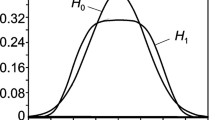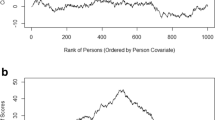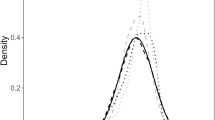Abstract
A Monte Carlo algorithm realizing a family of nonparametric tests for the Rasch model is introduced which are conditional on the item and subject marginals. The algorithm is based on random changes of elements of data matrices without changing the marginals; most powerful tests against all alternative hypotheses are given for which a monotone characteristic may be computed from the data matrix; alternatives may also be composed. Computation times are long, but exactp-values are approximated with the quality of approximation only depending on calculation time, but not on the number of persons. The power and the flexibility of the procedure is demonstrated by means of an empirical example where, among others, indicators for increased item similarities, the existence of subscales, violations of sufficiency of the raw score as well as learning processes were found. Many of the features described are implemented in the program T-Rasch 1.0 by Ponocny and Ponocny-Seliger (1999).
Similar content being viewed by others
References
Andersen, E.B. (1973). A goodness of fit test for the Rasch model.Psychometrika, 38, 123–140.
Andersen, E.B. (1980).Discrete statistical models with social science applications. Amsterdam: North-Holland Publishing.
Békéssy, A., Békéssy, P., & Komlós, J. (1972). Asymptotic enumeration of regular matrices.Studia Scientiarum Mathematicarum Hungarica, 7, 343–353.
Bents, R & Blank, R. (1991).Der Myers-Briggs Typenindikator (MBTI) [The Myers-Briggs type indicator]. Weinheim: Beltz. (In German)
Bukasa, B., & Wenninger, U. (1998). MAT.Nonverbaler Intelligenztest Testmanual [MAT. Nonverbal test of intelligence. Test manual]. Wien: Kuratorium für Verkehrssicherheit, Institut für Verkehrspsychologie. (In German)
Cressie, N., & Holland, P.W. (1983). Characterizing the manifest probabilities of latent trait models.Psychometrika, 48, 129–141.
Fischer, G.H. (1974).Einführung in die Theorie psychologischer Tests [Introduction to mental test theory]. Berne: Huber.
Fischer, G.H. (1981). On the existence and uniqueness of maximum likelihood estimates in the Rasch model.Psychometrika, 46, 59–77.
Fischer, G.H. (1993). Notes on the Mantel-Haenszel procedure and another chi-squared test for the assessment of DIF.Methodika, 7, 88–100.
Fischer, G.H. (1995). Some neglected problems in IRT.Psychometrika, 60, 449–487.
Fischer, G.H., & Molenaar, I.W. (Eds.). (1995).Rasch models. Foundations, recent developments, and applications. New York, NY: Springer.
Folks, J.L. (1984). Combination of independent tests. In P.R. Krishnaiah & P.K. Sen (Eds.),Handbooks of statistics, Vol. 4 (pp. 113–121). Amsterdam: North Holland.
Formann, A.K. (1979).WMT. Wiener Matrizen-Test. Ein Rasch-skalierter sprachfreier Intelligenztest [WMT. Viennese matrices test. A Rasch-scaled non-verbal test for intelligence]. Weinheim: Beltz. (In German)
Glas, C.A.W. (1988). The derivation of some tests for the Rasch model from the multinomial distribution.Psychometrika, 53, 525–546.
Glas, C.A.W. (1999). Modification indices for the 2-PL and the nominal response model.Psychometrika, 64, 273–294.
Glas, C.A.W., & Verhelst, N.D. (1995). Testing the Rasch model. In G.H. Fischer & I.W. Molenaar (Eds.),Rasch models. Foundations, recent developments, and applications (pp. 37–51). New York, NY: Springer-Verlag.
Jannarone, R.J. (1986). Conjunctive item response theory kernels.Psychometrika, 51, 357–373.
Kelderman, H. (1984). Loglinear Rasch model tests.Psychometrika, 49, 223–245.
Klauer, K.C. (1991). An exact and optimal standardized person test for assessing consistency with the Rasch model.Psychometrika, 56, 213–228.
Klauer, K.C. (1995). The assessment of person fit. In G.H. Fischer & I.W. Molenaar (Eds.),Rasch models. Foundations, recent developments, and applications (pp. 37–51). New York, NY: Springer-Verlag.
Ledermann, W., & Vajda, S. (Eds.). (1980).Handbook of applicable mathematics, Vol. I: Algebra. Chichester, U.K.: Wiley.
Lehmann, E.L. (1986).Testing statistical hypotheses. New York, NY: Wiley.
Li, M.F., & Olejnik, S. (1997). The power of Rasch person-fit statistics in detecting unusual response patterns.Applied Psychological Measurement, 21, 215–231.
Molenaar, I.W. (1983). Some improved diagnostics for failure in the Rasch model.Psychometrika, 48, 49–72.
Molenaar, I.W. (1995). Estimation of item parameters. In G.H. Fischer & I.W. Molenaar (Eds.),Rasch models. Foundations, recent developments, and applications (pp. 37–51). New York, NY: Springer-Verlag.
Neyman, J., & Pearson, E.S. (1933). On the problem of the most efficient tests of statistical hypotheses.Philosophical Transactions of the Royal Society, Series A, 231, 289–337.
Ponocny, I. (1996).Kombinatorische Modelltests für das Rasch-Modell [Combinatorial goodness-of-fit tests for the Rasch model]. Unpublished doctoral dissertation, University of Vienna, Austria.
Ponocny, I. (2000). Exact person fit-indexes for the Rasch model.Psychometrika, 65, 29–42.
Ponocny, I., & Ponocny-Seliger, E. (1999).T-Rasch 1.0. Groningen: ProGAMMA.
Prabhu, N.U. (1965).Stochastic processes. Basic theory and its applications. New York, NY: Macmillan.
Rao, C.R. (1973).Linear statistical inference and its applications (2nd ed.). New York, NY: Wiley.
Rasch, G. (1960).Probabilistic models for some intelligence and attainment tests. Kopenhagen: Danish Institute for Educational Research.
Raven, J.C. (1976).Standard progressive matrices. Oxford: Oxford Psychologists Press.
Stephens, M.A. (1986). Tests for the uniform distribution. In R.B. D'Agostino & M.A. Stephens (Eds.),Goodness-of-fit techniques. New York, NY: Dekker.
Verbeek, A., & Kroonenberg, P.M. (1985). A survey of algorithms for exact distributions of test statistics inr ×c contingency tables with fixed margins.Computational Statistics & Data Analysis, 3, 159–185.
Author information
Authors and Affiliations
Corresponding author
Additional information
The author wishes to thank Alexander Kaba, Birgit Bukasa, and Ulrike Wenninger of Österreichisches Kuratorium für Verkehrssicherheit (Austrian Traffic Safety Board) for allowing a data set to be used for the empirical example, and Elisabeth Ponocny-Seliger and the reviewers for many helpful comments. The menu-driven program T-Rasch 1.0 by Ponocny and Ponocny-Seliger (1999) can be obtained from Assessment Systems Corporation (http: //www.assess.com) or from the authors. (Note that it also performs exact person fit tests.)
Rights and permissions
About this article
Cite this article
Ponocny, I. Nonparametric goodness-of-fit tests for the rasch model. Psychometrika 66, 437–459 (2001). https://doi.org/10.1007/BF02294444
Received:
Revised:
Issue Date:
DOI: https://doi.org/10.1007/BF02294444




